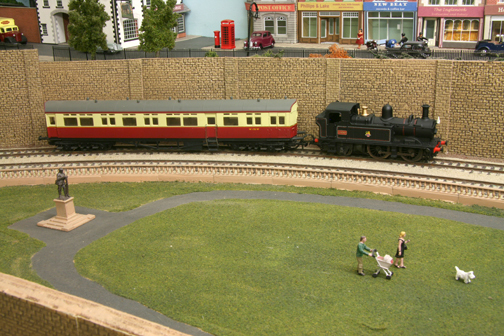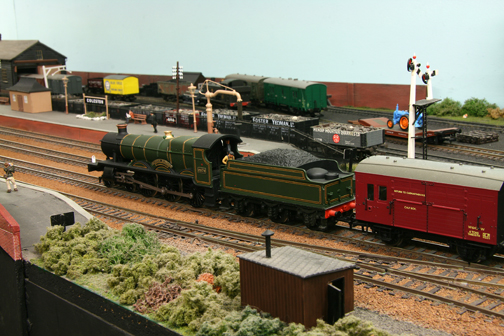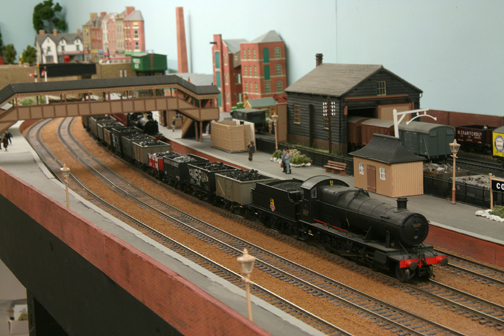Welcome to a selection of photographs featuring my layout, Coleston, as running circa 1950 (give or take a couple of years).
The late 1940s / early 1950s period was one of great upheaval for the railways of Britain. After 6 long, hard years of operating during the Second World War, often with only basic, minimal maintenance, the railways of the Big Four companies (GWR, LMS, LNER and SR) were in a very poor state. Politics dictated that the writing was on the wall for them anyway, and they were indeed nationalized by the then new Labour government on 1st January 1948.
Of course for we modellers, this meant a very interesting time, as the old liveries were to be eventually replaced by the new standard corporate ones, but not before a period of great experimentation, which threw up some weird and wonderful ideas on how the new British Railways was to look in the future. For a while, the various railway works all over the country, carried on building locomotives and rolling stock of traditional designs, outshopped in their own liveries in most cases, sometimes with an interim design of ownership markings (normally BRITISH RAILWAYS spelled out in full, in cream Gill Sans lettering - although the Western did use their own Egyptian-style font for this purpose), but often with no lettering at all. The new Western Region had to carry out livery experiments, which brought us apple-green 'Castles' and purple-blue 'Kings' amongst other curiosities. Eventually, Class 8 locos, of which the 'Kings' were the only example on the Western, were painted in a form of Caledonian blue, with white / black / white lining, which horrified some dyed-in-the-wool GWR fans. After some months of deliberations, the British Transport Commission decided on an only-slightly modified GWR green livery scheme for other express passenger locos (in power Classes 6 and 7) across the country, which left 'Castles' and 'Stars' in the 'old-company' colours, but 'Halls', 'Saints', and 'Counties' turned out in a pseudo LNWR livery of black, lined out in grey, cream and red - this deemed to be the new livery for mixed-traffic locomotives. All other locos were to be painted in plain black, although the last series of 10 'Manors', built at Swindon under BR auspices, did carry lined black for a while. Some black locos carried red-backed name and number plates, but this practice soon died out. Of course it took many years for the new nationalized colour schemes to permeate throughout the whole system, and on the Western, locos and rolling stock of both the old GWR and the new BR liveries could be seen working side by side well into the 1950s.
New liveries for infrastructure also took some time to implement, and some stations, especially those in out-of-the-way backwaters, were often left unpainted for many years. Which brings us nicely to the guise in which we see Coleston in this sequence of photographs - the station and its environs still in the 'old company's' colours, and rolling stock in a variety of interim liveries, which made this era all the more interesting.

No.2915 "Saint Bartholomew", in plain green livery, with BRITISH RAILWAYS in Egyptian-style lettering on the tender, seeing out his last days before withdrawal in October 1950, on stopping passenger duties. On this occasion an Oxford to Swindon service, and is seen waiting patiently in the 'down' bay at Coleston station. The station and its environs are still in the 'old company's' colours of light and dark stone. A Bedford OB-series bus is parked in the station approach, awaiting trade, whilst the driver of the MG TC 'Midget' makes a quick telephone call, and a Morris Z-series Post Office van waits for its expected load of parcels, backed up to the open gate.

A Collett 48XX 0-4-2T no.1450, looking very smart in its lined black, BR mixed-traffic livery with red-backed number plates, trails an autocoach around the curve passing Victoria Park on the approach to Coleston station.

No.7760, still in post-war GWR livery, shunting loco-coal wagons up the slope to the coaling stage at Coleston shed.

'Saint' Class no.2979 "Quentin Durward" passing Coleston on the 'down' through road. This loco was one of 13 built in 1905 as 'Atlantics', and all named after characters in Sir Walter Scott novels. They were all rebuilt as 4-6-0s in 1912 and absorbed into the 'Saint' class. This one carries GWR post-war livery but sans ownership markings - a common practice in 1948, as locos emerged from overhaul at Swindon works with a fresh repaint, but before the British Transport Commission had finalized their livery approach.

28XX heavy freight 2-8-0 no,2857 on the 'up' through road with a loaded coal train for the capital. In the early 1950s, there were still many thousands of ex-Private Owner wagons in service on BR metals. They were acquisitioned by the government at the outbreak of World War II and never returned to their previous owners. Maintenance for these vehicles during the war was limited to replacement of rotten or damaged planking, with no painting whatsoever, so quite often the pre-war ownership markings were difficult to read.

'Star' Class no.4019 "Knight Templar" on an 'up' milk train speeding through Coleston station. Just visible at the rear of the milk tanks is a Hawksworth full brake, in chocolate & cream livery but without ownership markings. The loco too wears a post-war Great Western livery, but with BRITISH RAILWAYS spelled out in full, in Egyptian font, on the tender.